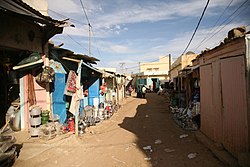Guidimaka Region
|
Guidimakha ولاية كيدي ماغة |
|
|---|---|
| Region of Mauritania | |

A street in Selibaby
|
|
 |
|
| Coordinates: 15°23′N 12°21′W / 15.383°N 12.350°WCoordinates: 15°23′N 12°21′W / 15.383°N 12.350°W | |
| Country |
|
| Departments | |
| Capital | Sélibaby |
| Area | |
| • Total | 10,300 km2 (4,000 sq mi) |
| Population (2013 census) | |
| • Total | 267,029 |
| • Density | 26/km2 (67/sq mi) |
Guidimaka (Arabic: ولاية كيدي ماغة) is the southern-most region of Mauritania. Its capital is Sélibaby. The region borders the Mauritanian region of Assaba to the north-east, Mali to the south-east, Senegal to the south-west and the Mauritanian Gorgol Region to the west.
As of 2013, the population of the region was 267,029, compared to 260,459 in 2011. There were 48.88 per cent females and 51.12 per cent males. As of 2008, the activity rate was 40.70 and economic dependency ratio was 1.22. As of 2008, the activity rate was 40.70 and economic dependency ratio was 1.22. As of 2008, the literacy rate for people aged 15 years and over was 27.30. The location government is headed by an elected district representative, while the elections for the local government are conducted every five years. On account of the political instability, the last elections were held in 2006.
Mauritania is mostly covered with desert, with only its western regions around the coast of Atlantic Ocean having some vegetation. There are some oasis in the desert regions. Since it is a desert, there are large shifting dunes forming temporary ranges. The average elevation is around 460 m (1,510 ft) above the mean sea level. The rainfall in the northern regions closer to the Tropic of Cancer receives around 100 mm (3.9 in) of annual rainfall compared to the southern portions that receives around 660 mm (26 in). The average temparature is 37.8 °C (100.0 °F), while during the night it reaches 0 °C (32 °F). Due to the geography, the inhabitants historically, have been nomadic. In modern times, people have migrated to urban centres during the drought in 1970 and 1980. There are a few sedantary cultivators, who are located only in the Southern regions of the country. Research has indicated that the Saharan movement has resulted in reduction of rains in the region from the 1960s, when it received close to 250 mm (9.8 in) of rainfall.
As of 2013, the population of the region was 267,029, compared to 260,459 in 2011. There were 48.88 per cent females and 51.12 per cent males. As of 2008, the couples with children was 40.60 and Couples without children was 7.20. The proportion with extended family was 23.00 per cent and extended single-parent was 5.50 per cent, one-person was 4.40 per cent, and single-parent nuclear was 19.30 per cent. As of 2008, the rate of household confirming the existence of public telephone in their neighbourhood or village was 73.71, rate of households benefiting from electricity post in their neighbourhood was 0.75 per cent, rate of households benefiting from health centre or health post in their neighbourhood was 8.61 per cent, and rate of households benefiting from sanitary services was 0.16 per cent.
...
Wikipedia
